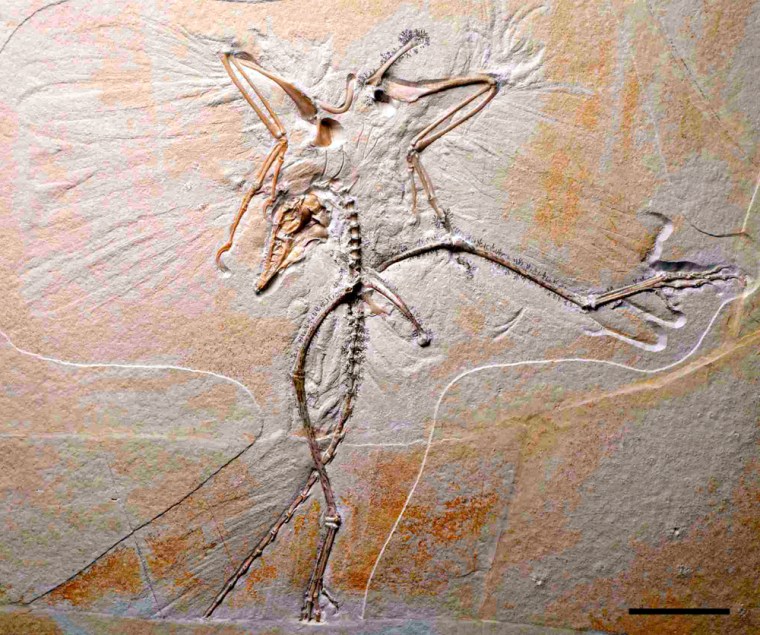A rare and prized fossil of the feathered Archaeopteryx — thought to be Earth's first bird — has become something of an albatross to a small Wyoming museum.
While the scientific significance of the fossil is unquestioned and its monetary value thought to be in excess of $1 million, the fact that it is bound for a private museum has drawn scorn from some scientists.
"Ethically, in our profession, if a specimen is not in the public domain its scientific worth is about zero," said Kevin Padian, a curator of paleontology and professor at the University of California at Berkeley.
But officials at the Wyoming Dinosaur Center in Thermopolis, where the fossil eventually will be on display, give assurances that it will be available for scientific study and public access.
They acknowledge that the situation of ownership is not perfect, but say it's better than not having the fossil available at all to study.
"If you can show me what's wrong with that, I'm more than happy to put it back in a bank in Switzerland," said Wyoming Dinosaur Center owner Burkhard Pohl, who brokered the sale of the fossil from one private owner to another.
10 such fossils in the world
The Archaeopteryx was a birdlike creature about the size of a crow, with teeth, a lizardlike tail and wings. It lived about 150 million years ago and many scientists consider it the "first bird" because it had wings and was the first fossil found with feathers.
Only 10 Archaeopteryx fossils are known to exist — all in Europe.
The specimen heading to Thermopolis, a town of 3,100 people in central Wyoming, is the newest and among the most complete. About a foot square in size, it is encased in a slab of limestone dug up in Germany.
It is now housed at the Senckenberg museum in Frankfurt, where it will stay until the Thermopolis museum can install proper security and display case, expected sometime next year.
Kirk Johnson, chief curator of the Denver Museum of Nature and Science, said the rarity and completeness of the skeleton leads him to believe "it must be worth millions. How many, I don't know."
Who actually owns the bird?
Pohl succeeded in finding someone to buy the Archaeopteryx fossil and make it available to scientists who visit the Thermopolis museum. Officially, the fossil is on loan to the Wyoming museum.
Pohl has refused to release details of the negotiations or the agreement with the new owner, except for provisions that he says guarantee that the fossil always be available for public display and study even if the current owner dies, sells it or the Wyoming museum closes.
But for scientists like Padian, the agreement isn't good enough.
Because no one has seen any documents on the agreement, Padian said that as long as the fossil is privately owned, there's the possibility it could be taken away from scientific study by the owner or the owner's heirs.
Scott Hartman, science director at the Wyoming museum, said most scientists haven't voiced similar concerns. "The funny thing is 99 percent of the responses we've gotten have all been congratulatory or offers to work with us," he said.
An initial analysis of the fossil has bolstered theories that the Archaeopteryx evolved from dinosaurs because the specimen's feet clearly showed toes with the same characteristics of toes on dinosaurs. It also dispelled theories that the animal had perching feet like modern birds.
Feather in Wyoming’s cap
Opened in 1995, the Wyoming Dinosaur Center is the state's first facility dedicated to excavating, preparing and displaying dinosaur bones discovered within the state. Historically, most of the dinosaur fossils dug up in Wyoming were shipped out for display.
Johnson, of the Denver museum, said he had no problem with the Wyoming museum displaying the Archaeopteryx. "I think it's a cool opportunity," he said. "I certainly will go see it myself."
Hartman said about 18 scientists are on a list to study the fossil when it goes on display in Thermopolis. Among those eager for a view is independent geologist and paleontologist Marilyn Wegweiser.
"In this case, the Wyoming Dinosaur Center has given the United States an unprecedented fossil," Wegweiser said. "Everyone wants to see it. It's the only one on this side of the ocean."
